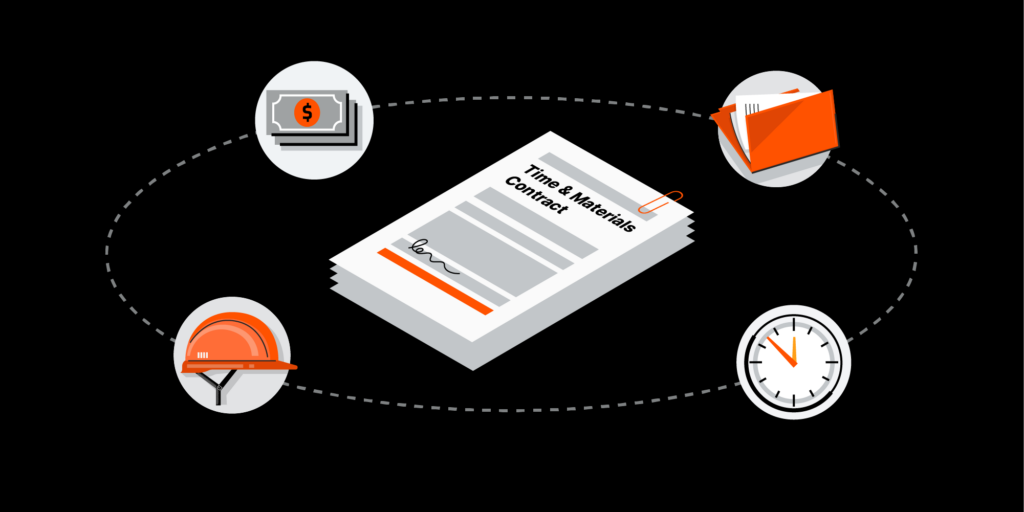— 12 min read
The 5 Key Types of Construction Contracts


Last Updated Sep 10, 2025

Ryan O'Donnell
Senior Product Manager, Construction Financials
Ryan O'Donnell works at Procore as Senior Product Manager, Financials. He has spent his career working in construction finance -- including roles as Controller & CFO for Terminal Construction Corporation in NYC, AVP of Commercial Real Estate at M&T Bank, and Senior Auditor for Kiewit Infrastructure Group. Ryan earned his MBA in Accounting & Finance from Rutgers University. He lives in New York.

Daniel Gray
Contributing Writer
32 articles
Daniel is an educator and writer with a speciality in construction. He has been writing construction content for Procore since 2022, and previously served as a Procore Content Manager before continuing to pursue an education career as an Assistant Headmaster for Valor Education in Austin. Daniel's experience writing for construction — as well as several clients under an agency — has broadened his knowledge and expertise across multiple subjects.

Kristen Frisa
Contributing Writer
111 articles
Kristen Frisa is a contributing writer for Procore. She also contributes to a variety of industry publications as a freelance writer focused on finance and construction technology. Kristen holds a Bachelor of Arts in Philosophy and History from Western University, with a post-graduate certificate in journalism from Sheridan College. She lives in Ontario, Canada.
Last Updated Sep 10, 2025

There are five common types of construction contracts: lump sum (or fixed price), time and materials (T&M), unit price, guaranteed maximum price (GMP), and cost-plus. Each of these contract types is suitable for some projects and not others, and each has both advantages and disadvantages for the various stakeholders involved in a construction project.
Notably, many projects involve different contract types for different phases or aspects of the job. Learning more about every type of construction contract can help you find the right terms to manage financial risk on your project.
Table of contents
Construction Contracts Overview
Every construction project has unique challenges, and different types of contracts lend themselves to various situations.
| Contract Type | Definition | Description |
|---|---|---|
| Lump sum | Parties agree on a fixed price for the entire project or phase. | Best for projects with a well-defined scope of work. |
| Time and materials | Contractors bill for all material costs and labour at an hourly rate. | Helpful for projects with uncertain scope. |
| Unit price | Work is divided into fixed-cost units, and contractors bill for each unit separately. | Useful for projects with an uncertain number of repeatable elements. |
| Guaranteed maximum price (GMP) | Contract sets an upper limit for costs, and the general contractor (GC) or construction manager absorbs additional costs. | Reserved for projects with known scope and challenges. |
| Cost-plus | Contractors are paid for project costs plus a predetermined profit margin. | Beneficial for contractors on projects with many potential change orders. |
Understanding the risks and benefits of each contract type can help you make the best choice for your project. Ultimately, selecting the right contracts for your projects is an important part of construction financial management, since contracts directly affect your expenses, revenue, and profit.
1. Lump Sum Contracts
Lump sum contracts, also called fixed price contracts, establish a fixed price for all of the materials and labour required to complete a job.
This is the most basic and common type of construction contract. Lump sum contracts work especially well for projects with a well-defined scope of work, which enables contractors to make an accurate estimate of the project’s cost, considering Canada’s provincial and federal taxes and regulations. It is necessary for contractors to be mindful of the provincial taxes like GST/HST or PST (Provincial Sales Tax) which vary by province. For instance, Alberta has no PST, while Quebec has both GST and QST (Quebec Sales Tax), influencing the overall cost of the project.
While lump sum contracts are extremely useful, they do have drawbacks.
| Advantages | Disadvantages |
|---|---|
| May lead to higher profit margins. A well-calculated tender can cover all project costs and leave a healthy profit margin. | Potential incentive to cut corners. Since the final cost is set in stone, contractors may wish to cut corners in order to increase their profit margin. |
| Easily compare tenders. With fixed total costs, property owners or developers can choose among tenders with ease. | Costs can cut into profits. If contractors are not careful about managing costs, their profit margin can disappear. |
Lump sum contracts are helpful for property owners or developers during the tendering phase, but during construction, owners have to be mindful that the general contractors are incentivized to come in under budget. For that reason, many owners choose to hire a construction manager as their representative on the job site.
Lump sum contracts also benefit general contractors, especially those who create accurate estimates and tenders. With a fixed total cost for the project, GCs who manage their costs during construction can end up with a robust profit margin.
2. Time & Materials Contracts
Time and materials contracts — also called T&M contracts — reimburse contractors for material costs and pay a fixed daily or hourly wage for labour costs.
This type of contract offers additional protection for contractors, who have greater assurance that their costs will be covered throughout the project.
Notably, material and labour costs have several additional factors built into the contract:
- Material costs include the cost of the materials themselves, the freight charges, and a markup charge (typically between 10 and 30 percent).
- Labour costs include the base pay, overhead and administrative costs, and a profit margin. This is called the loaded labour rate.
Time and materials contracts can be beneficial in many situations, but it’s important to also understand the risks of this contract type.
| Advantages | Disadvantages |
|---|---|
| Mitigates risk for general contractors. Because the owner pays for actual costs, the GC can manage delays and changes. | Increases risk for owners. Unless a “not-to-exceed” clause is built into the contract, owners face unknown and potentially high costs. |
| Profit is predictable. Markup is built into both material and labour costs, so the GC knows their profit margin. | Tracking costs can be burdensome. Contractors face the administrative challenge of tracking and submitting labour hours and material costs. |
For many property owners, a T&M contract is less appealing than a fixed-price contract because the total cost is unknown at the start of construction. That said, many time and materials contracts include “not-to-exceed” clauses that set a maximum price or a maximum number of labour hours. These clauses can create incentives for the general contractor to complete work in a timely manner and under budget — otherwise, they’ll cut into their own profit margin.
For contractors, a T&M contract relieves the burden of creating a perfect estimate. All construction projects involve risks, unknown variables, delays, changes, and more. With a time and materials contract, contractors mitigate their own risk with the assurance that a project will stay profitable even when it encounters roadblocks. That said, the profit upside for this type of contract may be more limited as well.
For example, a contractor building 10 km of highway may sign a unit price contract, with each kilometre of highway representing a unit. The same labour and materials will be used for each section of road, so the contractor bills for each of those units at a fixed price. If the scope of the project changes — for instance, if additional sections of the highway need to be built — the contractor simply bills for additional units upon completion.
Unit price contracts are especially helpful for situations where it’s unknown how many units of work will be needed. For example, a contractor may remove dirt during site preparation, billing for every cubic metre of soil removed as a unit with a fixed cost.
Importantly, the unit price includes all of the contractor’s costs — labour, materials, overhead — and a markup for profit.
| Advantages | Disadvantages |
|---|---|
| Simplifies tracking and billing. Rather than billing for labour hours or materials, contractors simply bill for each unit. | Poor pricing can sink contractors. While unit price contracts offer flexibility, a poorly priced unit can destroy contractor profit. |
| Supports flexible projects. Projects that have an unknown scope or duration match well with unit pricing. | Owner does not know the total cost. Although property owners or developers will know the unit cost, they may not know the total number and units required. |
For property owners or developers, unit pricing has the advantage of simplifying the overall contract negotiation. However, unit pricing can also obscure the full scope of a project, so owners need to be mindful that they understand roughly how many units are likely to be billed.
Contractors benefit from unit pricing since they have less administrative overhead by billing for units rather than labour hours or materials. However, contractors using unit pricing must be careful to ensure their prices cover all of their costs (including overhead) and provide a profit.
3. Unit price contracts
Unit price contracts set a fixed price for a distinct, repeatable aspect of a project, which is defined as a “unit.”
For example, a contractor building 10 km of highway may sign a unit price contract, with each kilometre of highway representing a unit. The same labour and materials will be used for each section of road, so the contractor bills for each of those units at a fixed price. If the scope of the project changes — for instance, if additional sections of the highway need to be built — the contractor simply bills for additional units upon completion.
Unit price contracts are especially helpful for situations where it’s unknown how many units of work will be needed. For example, a contractor may remove dirt during site preparation, billing for every cubic metre of soil removed as a unit with a fixed cost.
Importantly, the unit price includes all of the contractor’s costs — labour, materials, overhead — and a markup for profit.
| Advantages | Disadvantages |
|---|---|
| Simplifies tracking and billing. Rather than billing for labour hours or materials, contractors simply bill for each unit. | Poor pricing can sink contractors. While unit price contracts offer flexibility, a poorly priced unit can destroy contractor profit. |
| Supports flexible projects. Projects that have an unknown scope or duration match well with unit pricing. | Owner does not know the total cost. Although property owners or developers will know the unit cost, they may not know the total number and units required. |
For property owners or developers, unit pricing has the advantage of simplifying the overall contract negotiation. However, unit pricing can also obscure the full scope of a project, so owners need to be mindful that they understand roughly how many units are likely to be billed.
Contractors benefit from unit pricing since they have less administrative overhead by billing for units rather than labour hours or materials. However, contractors using unit pricing must be careful to ensure their prices cover all of their costs (including overhead) and provide a profit.
4. Guaranteed Maximum Price (GMP) Contracts
A guaranteed maximum price (GMP) contract sets a maximum project cost for the property owner or developer. Any costs that exceed the maximum price are the responsibility of the general contractor, who will see their profit margin cut as a result.
With a GMP contract, a general contractor uses a schedule of values to estimate the total project cost. In addition to these direct costs, the contractor will also include overhead costs and profit. With this type of contract, the general contractor acts as a construction manager at risk (CMAR). The CMAR oversees the project from start to finish, and they are at risk of paying out-of-pocket for going over budget.
| Advantages | Disadvantages |
|---|---|
| Reduced risk for owners. Owners know the maximum cost before a project begins. | Risk of cost overruns for GC. The GC must carefully price the project or risk paying out of pocket. |
| Simplifies project for GC. Project plans are often finalized before construction, so change orders are minimized. | Administrative cost to accounting transparency. Contractors must maintain intricate accounting records for owners to review as part of the contract. |
For owners, GMP projects avoid concerns about going over budget since the maximum price is set before construction begins. Additionally, most GMP contracts include a stipulation that owners can review the financial records of the contractor, so owners can audit the project costs to ensure fairness.
For contractors, GMP projects are often simpler since many project details are worked out ahead of time, reducing the need for change orders. However, contractors also face two significant risks with guaranteed maximum price contracts: cost overruns and administrative burden.
Without a very accurate schedule of values, contractors risk setting the GMP too low and paying out of pocket for project costs. Additionally, the open book clauses require a high degree of financial transparency that adds to the project’s administrative costs.
5. Cost-plus Contracts
A cost-plus contract reimburses contractors for construction costs — labour, materials, and equipment — along with a predetermined markup rate or fixed fee.
With cost-plus contracts, both direct and indirect costs are covered, and markup is typically calculated as a specific percentage of the total costs. Direct costs are those specifically related to the project (like labour, materials, or equipment just for that job) while indirect costs are the overhead required to keep the business running (like insurance, office space, and software subscriptions).
While all direct costs are covered in a cost-plus contract, indirect costs are usually covered on a percentage basis, with the exact amount varying according to the length and scope of the project.
Notably, a contractor cannot simply bill for costs without any justification. Before the project begins, the contractor provides the owner with an estimate of costs. The contract may also stipulate a maximum point beyond which costs will not be reimbursed.
| Advantages | Disadvantages |
|---|---|
| Lower risk for contractors. Contractors know their costs will be reimbursed even if prices rise. | Project cost is unknown. The owner does not know the full cost ahead of time. |
| Incentives to manage costs. Both owners and contractors are incentivized to manage the project costs. | Meticulous expense tracking. Contractors must carefully track expenses to submit for reimbursement. |
For owners, cost-plus contracts leave some uncertainty about the total project cost, but that can be remedied with a cap on cost reimbursement. Additionally, some cost-plus contracts include performance bonuses or other incentives that encourage contractors to come in ahead of schedule and under budget.
For contractors, cost-plus contracts reduce risk and uncertainty since they’ll be reimbursed even if prices on materials or labour rise. However, contractors must be careful to calculate their indirect costs correctly to ensure that their profit isn’t ultimately used to cover overhead.
Which contract is right for your job?
There is no one-size-fits-all contract for construction, and there isn’t a perfect contract for any situation. That said, there are guidelines you can follow to choose a contract type that is likely to match well with a project.
Here are a few things to keep in mind:
- If your project has a well-defined scope of work, a lump sum contract is a straightforward solution since contractors should be able to accurately estimate costs.
- If the project scope is unclear, contractors can tender with time and materials contracts to mitigate risk.
- If the project involves repeated work, unit price contracts offer simplified pricing and the ability to easily expand the project scope.
- If the project has a fixed budget, guaranteed maximum price contracts reduce the owner’s financial risk.
- If the project involves uncertainty in estimating, a cost-plus contract can get the project off the ground quickly with limited risk for contractors.
It’s possible to use different contract types for each phase or aspect of a larger project, and many contracts include overlap among several types. For instance, it’s common for cost-plus projects to include a maximum price.
Regardless of the type of contract you work under, read the conditions carefully. Understanding the contract is one of the most important steps to mitigating financial risk on a job.
Categories:
Written by

Ryan O'Donnell
Senior Product Manager, Construction Financials
Ryan O'Donnell works at Procore as Senior Product Manager, Financials. He has spent his career working in construction finance -- including roles as Controller & CFO for Terminal Construction Corporation in NYC, AVP of Commercial Real Estate at M&T Bank, and Senior Auditor for Kiewit Infrastructure Group. Ryan earned his MBA in Accounting & Finance from Rutgers University. He lives in New York.
View profile
Daniel Gray
Contributing Writer
32 articles
Daniel is an educator and writer with a speciality in construction. He has been writing construction content for Procore since 2022, and previously served as a Procore Content Manager before continuing to pursue an education career as an Assistant Headmaster for Valor Education in Austin. Daniel's experience writing for construction — as well as several clients under an agency — has broadened his knowledge and expertise across multiple subjects.
View profileReviewed by

Kristen Frisa
Contributing Writer | Procore
111 articles
Kristen Frisa is a contributing writer for Procore. She also contributes to a variety of industry publications as a freelance writer focused on finance and construction technology. Kristen holds a Bachelor of Arts in Philosophy and History from Western University, with a post-graduate certificate in journalism from Sheridan College. She lives in Ontario, Canada.
View profileExplore more helpful resources

The 5 Key Types of Construction Contracts
There are five common types of construction contracts: lump sum (or fixed price), time and materials (T&M), unit price, guaranteed maximum price (GMP), and cost-plus. Each of these contract types...

Time and Materials (T&M) Contracts in Construction: Guide for Contractors & Project Owners
A time and materials (T&M) contract is a construction agreement where the project owner pays the contractor for all material and labour costs on a project as well as contractor...

Invitation to Tender (ITT) Explained for Construction
An invitation to tender (ITT) is an official document issued by a project owner that targets contractors to solicit tenders for a construction project. The ITT provides all tenderers with...

How Construction Feasibility Studies Guide Building Decisions
There are countless steps taken by stakeholders to ensure the success of a construction project — and many questions that need answering before getting started. Can the project be built...